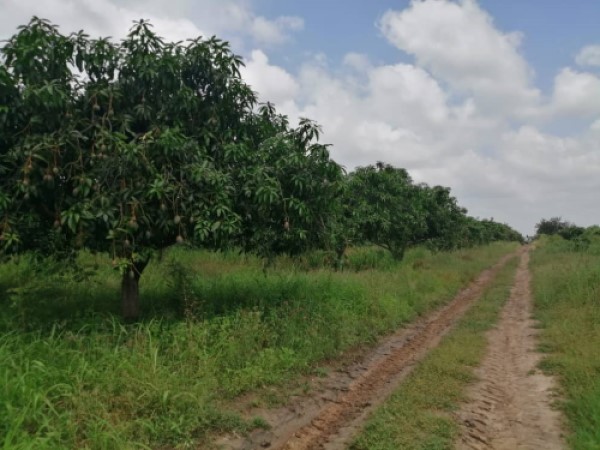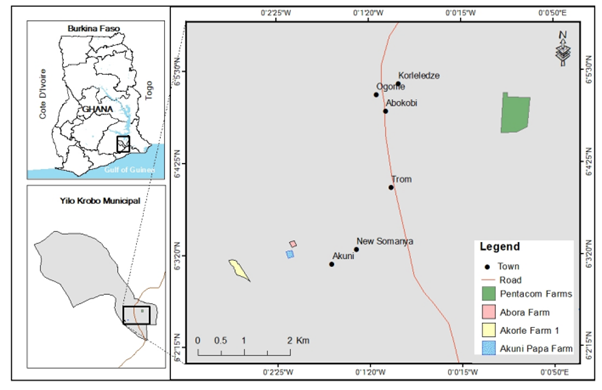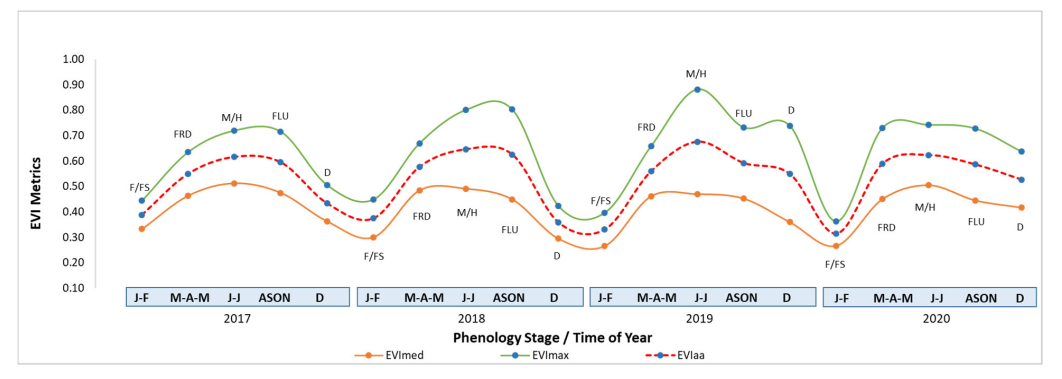Did you know that you can watch a mango tree grow from space? A new study (1) by Benjamin Adjah Torgbor et al. has been assessing the potential of the Digital Earth Africa platform and services to assess the productivity of mango orchards in Ghana.

Mangoes are one of the most popular tropical fruits on the global market, accounting for approximately half of all tropical fruits produced. An estimated 99 percent of tropical fruit production takes place in developing countries by smallholder farmers (2) with Africa producing approximately 10 percent of the worldwide mango crops.
The mango (Mangifera indica L) is one of the most important crops to the economy of Ghana (3) due to the combination of a favourable climate and Ghana’s proximity to the European market providing major potential for fresh mango exports. In Ghana, mango farms are often run by small to medium scale producers who often grow a single variety, in a farming practice known as monoculture.
Mangoes are a long-living tree, but only bear fruit after 6 years, with a three to six month ripening period. The time required to establish a mango tree makes them vulnerable to changes in climatic conditions and, at times, an unreliable crop for farmers.
To combat this, farmers often use the space in between mango trees to cultivate food crops such as maize, yam and plantain, providing extra income to support the mango trees when they are young. These tactics make mango production more financially sustainable for farmers as well as contributing to the food security of the area. Research into optimal growing conditions and sustainable management practices can help further the expansion, productivity and profitability of the mango industry in Ghana.
Understanding mangoes in Ghana
Using innovative technologies can help to understand growing patterns in current mango farms across Ghana, empowering farmers to inform and adapt future farming practices. In their study, Benjamin Adjah Torgbor et al. assessed the potential of temporal remote sensing, using Sentinel-2 satellite imagery to understand the annual growth phases of mangoes at four farms in the Yilo Krobo Municipal Area of Ghana.

Understanding the growth profiles of commercial mango orchards using remote sensing can inform near ‘real-time’ technology, designed to track the performance of orchards. The imagery can help to identify growing rates as well as variations due to pests, diseases or impacts of the weather. In a changing climate it is important to understand the patterns of the past, in order to make informed predictions about future climate and weather conditions and enable decision making that will allow the mango farms to remain sustainable into the future.
Seasonal growth curves were produced for the study area using data extracted from the Digital Earth Africa platform. Four different vegetation indices were used; NDVI, GNDVI, EVI and SAV, from 2017 to 2020. This data aligned with the five known phenology stages of the mango tree, namely; flowering/fruitset, fruit development, maturity/harvesting, flushing and dormancy.
These results confirmed that through remote sensing alone you can identify the productivity of commercial mango farms in Ghana without the requirement for physical inspection of the crops.
Traditionally, assessing the phenology of crops requires laborious and time consuming field work. This also limits the size of the area that can be assessed. Using remote sensing enables larger scale assessments in a much shorter time. Benjamin chose Digital Earth Africa tools and services for his project because of the data available for the study area and the ease of use of the platform. For Benjamin, the analysis ready Sentinel-2 data made it much easier to conduct the research. Working on multiple metrics across four farms was simplified thanks to the tools and services available from Digital Earth Africa.
“The Notebooks in the Sandbox make work even more amazing as the scripts were easy to modify and produce results,” said Benjamin.

What is next?
Benjamin is now working on a new project using SAR (Sentinel-1) to assess the potential of retrieving phenology states of mangoes in Ghana. The early results are promising and there is hope that the project could be presented at a conference later in 2022. In the future, Benjamin hopes to be able to predict specific dates of the phenology change of mango crops. He also hopes to undertake yield modelling as part of the wider PhD project. Granular detail of the behaviour of crops is valuable information for on-farm crop management practices, and can help develop yield prediction models and optimise harvest logistics.
“I highly recommend the ‘Real World Examples’ in the Sandbox environment. The practical examples can suit many ideas and I have always found help when contacting the DE Africa team.
The study “Assessing the Potential of Sentinel-2 Derived Vegetation Indices to Retrieve Phenological Stages of Mango in Ghana,” is a part of a PhD research being undertaken by the author, Benjamin A. Torgbor with four supervisors (Dr. Moshiur Rahman, Prof. Andrew Robson, Prof. James Brinkhoff and Dr. Azeem Khan) at the Applied Agricultural Remote Sensing Centre (AARSC) of the University of New England in Armidale, Australia. Benjamin currently hold partnerships and collaborations with the AARSC-UNE in Australia, colleagues in the University of Guelph, mango growers in the Somanya area and is currently employed by the Forestry Commission in Ghana.

Benjamin Adjah Torgbor is a Forester, Drone Pilot and Geospatial Engineer with the Forestry Commission of Ghana where he works as a Regional Manager at the Headquarters in Accra. He holds a double MSc degree in Geoinformation Science and Earth's Observation for Environmental Modeling and Management (MSc-GEM) from the Lund University in Sweden and the ITC University of Twente in the Netherlands. Benjamin is currently a PhD candidate at the University of New England in Armidale, Australia working on Mango yield prediction modeling.
References
- Torgbor, B.A.; Rahman, M.M.; Robson, A.; Brinkhoff, J.; Khan, A. Assessing the Potential of Sentinel-2 Derived Vegetation Indices to Retrieve Phenological Stages of Mango in Ghana. Horticulturae. 2022, 8, 11.
- Special feature FAO - Global prospects for major tropical fruits. Sabine Altendorf.
- Okorley, E.L.; Acheampong, L.; Abenor, M.T. The current status of mango farming business in Ghana: A case study of mango farming in the Dangme West District. Ghana J. Agric. Sci. 2014, 47, 73–80. 4.